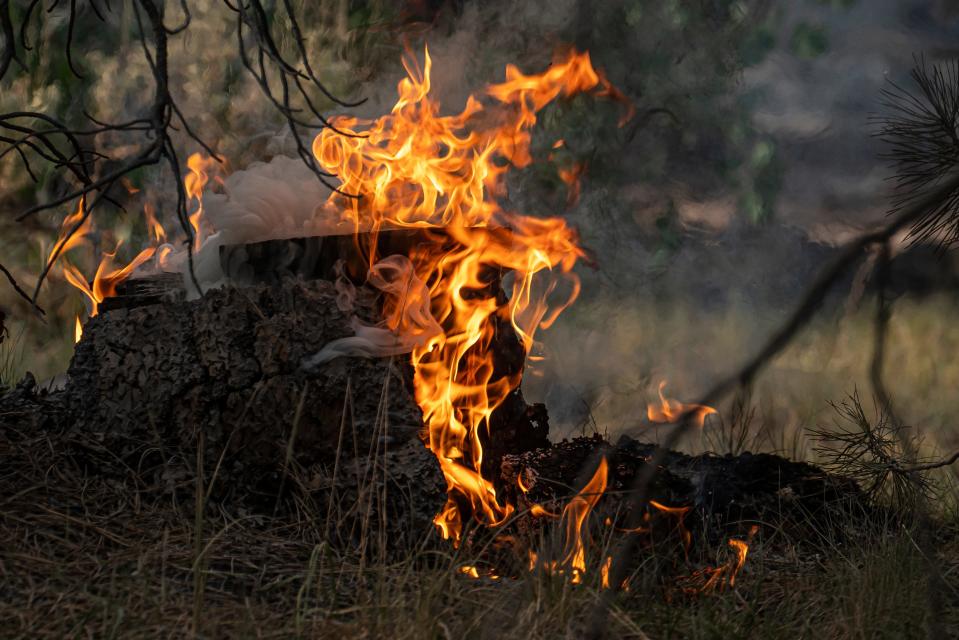Biden and Congress are so close to a grand plan for climate action and economic recovery
What now makes up the American West hasn’t been this dry in at least four centuries. The nation’s largest reservoir, Lake Mead, which supplies water to 25 million people in Arizona, California and Nevada, is two-thirds empty, its lowest level ever.
From the Columbia River to the San Joaquin Delta, hundreds of thousands of salmon are dying in water too warm to support them.
With firefighters battling nearly 85 major blazes, wildfires have already torched enough land this year to cover the state of Delaware, with months left to go in the wildfire season.
Faced with withering pasture and rising prices for feed, cattle ranchers are culling their herds, while farmers of everything from cherries to wheat are watching crops wilt or letting fields go fallow – and paying a steep price in mental health.
Negotiations too important to fail
“I can see my future,” third-generation California fruit grower David Mas Masumoto writes of this summer’s record heat and drought. “It’s dry, thirsty and bleak.”
And destined to get more so, the science makes clear, unless we cut the dangerous carbon pollution from burning fossil fuels in half from 2010 levels by 2030, and stop adding it to the atmosphere altogether by 2050.
Bridging divides: We're conservatives and we're fighting against climate change: Here's how.
President Joe Biden’s agenda to Build Back Better in the coronavirus pandemic’s wake promises to set the nation on track to achieve those goals in a way that weds equitable recovery to climate action – in a moment the country urgently needs both.
Now it’s on Congress to fund the plan. Two-track negotiations over how to do it have entered a critical stage. They cannot be allowed to fail.
A Senate procedural vote last Wednesday tapped the brakes on the congressional process, buying time for negotiators to nail down additional specifics to the infrastructure framework agreed on last month by a team of Democrats and Republicans. Backers from both parties are continuing negotiations this week on a detailed package of investments to revitalize aging bridges and roads, modernize the electric power grid and bring high-speed internet to rural communities.

The bipartisan infrastructure package is the first in a two-step process. Congressional leaders must then finish the job with sister legislation that can be passed in both houses with Democratic votes, if necessary, to ensure America does what it takes to confront the widening climate crisis.
This starts with cleaning up the dirty power plants that account for about a third of the nation’s carbon footprint. Biden has called for strategic investment to do just that, by, for example, making our homes and workplaces more efficient; helping us get more clean power from the wind and sun; and modernizing our power grid and storage system.
That would position the country to meet Biden’s goal of getting 80% of our electricity without fossil fuels by 2030, and 100% clean power by 2035.
No time for delay: Climate change is no longer other worldly, and inaction is no longer an option
We’ve also got to cut carbon pollution in the transportation sector that accounts for roughly another third of our carbon emissions. Building Back Better would help us do that, too, first by building half a million charging stations nationwide, to speed the shift to electric cars and light trucks.
Small changes can have a big impact
That’s important. Every gallon of gasoline we burn pumps about 20 pounds of carbon pollution into the atmosphere, where it stays and contributes to climate change. General Motors and other auto giants are transitioning to mostly electric vehicles over the next 15 years. More charging stations will make it easier for drivers to make the shift.
Biden’s plan also calls for the largest investment ever in sustainable public transit, especially for the low-income communities that depend on it to get to work or school. It includes funding to reconnect historically disadvantaged neighborhoods that were sliced up decades ago by misguided highway routes. And it ensures that at least 40% of the public investment in a clean energy future benefits the people of color who long have paid the highest price for climate hazard and harm.
Opinions in your inbox: Get the best insights and analysis delivered to your inbox
This is a grand strategic vision to shore up our aging infrastructure and make our economy more competitive, especially in the fast-growing clean energy market that’s projected to draw $30 trillion in global investment over just the next two decades. It will create millions of jobs, including for workers who want to belong to a union. And it will make our society more equitable, addressing in real and meaningful ways the environmental injustice too many of our people have suffered for too long.
It’s time for the Congress to come through for our families, communities and nation. It’s time to fully fund Biden’s agenda to Build Back Better for everyone, for the sake of the durable recovery we need, and the climate action we must take now.
Mitchell Bernard is president of the Natural Resources Defense Council, an environmental group with more than 3 million supporters nationwide.
You can read diverse opinions from our Board of Contributors and other writers on the Opinion front page, on Twitter @usatodayopinion and in our daily Opinion newsletter. To respond to a column, submit a comment to letters@usatoday.com.
This article originally appeared on USA TODAY: Joe Biden agenda is clear path to climate action and economic recovery

 Yahoo Movies
Yahoo Movies 